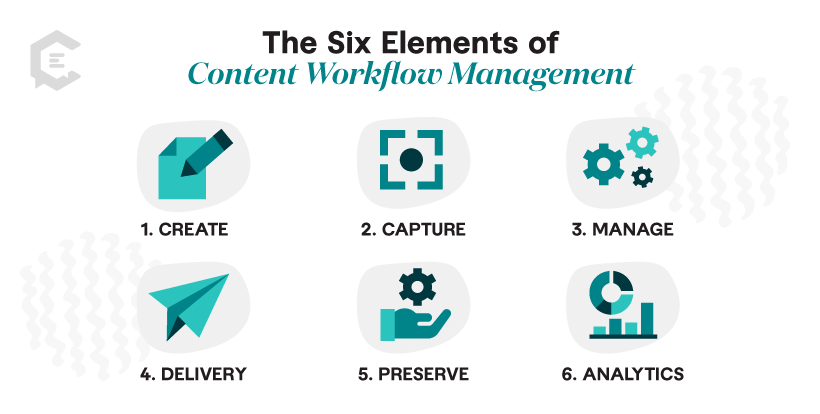Case studies are a valuable part of any content marketing strategy. They can be an ideal tool for showcasing your specific product or service.
However, not all case studies are created equally. Some are more effective than others in introducing and solving content strategy challenges.
In this article, we’ll share best practices for developing a worthwhile content marketing strategy using case studies of real-world examples. We’ll also discuss multiple areas of your strategy, including workflow management, talent management, SEO, and content scalability.
Workflow Management — Getting From Start to Finish
Many companies assume that generating lots of content is an effective content strategy. Unfortunately, that assumption is incorrect. There also needs to be a structure in place to develop and disseminate your content.
One way to avoid the “all-or-nothing” content strategy is to focus on workflow management.
Content workflow management is a series of tasks that take content from ideas to delivery as efficiently as possible. It consists of six elements:
- Create
- Capture
- Manage
- Delivery
- Preserve
- Analytics
Within these six sections are sub-modules, which are:
- Creating and writing content
- Filing and sharing
- Social and collaboration
Workflow is essential because it helps break content creation and production into straightforward, manageable tasks you can execute smoothly.
Case study: Narrato
Narrato’s case study examines how a content agency moved its content creation process to Narrato’s Workspace. It outlines all the steps taken that helped simplify the many moving parts of a content workflow strategy.
But, the challenge with this case study is how hard it is to follow verbally and visually. Images of the user interface provide examples, but the presentation is unclear, which isn’t what you want. Case studies should have a clear flow and structure that’s easy to follow.
Case study: FreshLime
Our FreshLime case study focuses on workflow issues involved with content creation.
FreshLime is an online platform that helps clients increase their revenue through customized content services. Since their clients operate in various sectors, FreshLime needed content creators with specific industry expertise. And, because of the sheer amount of content required, FreshLime needed a way to track the content creation process.
Our content platform helped FreshLime layout procedures from start to finish, creating seamless collaboration between FreshLime and ClearVoice. We also developed and maintained a content calendar to track FreshLime’s client content requirements.
Takeaway
Although content is an end goal, workflow management is the cornerstone of any content marketing strategy.
Talent Management — Finding & Keeping the Right Creators
The key to quality content is quality content creators. But good writers and content creators are notoriously tricky to find.
So, how do you find the right talent for your business?
The first step is to examine what type of content you need. Then, determine the creator’s role in developing that content. It’s also necessary to outline anticipated volume and frequency.
Before bringing the content creator on board, examine their:
- Skill level
- Experience
- References
- Level of audience understanding
- Fit into the company’s budget
The question then becomes where to source that talent from. There are a lot of “content services” available. Quality solutions, like ClearVoice, ensure experienced content creators through in-depth vetting and hiring processes.
Case study: Cisco
Our Cisco case study focuses on their CloudCherry acquisition. After they acquired it, Cisco instituted a rebrand, which required content support. Cisco turned to us, and we facilitated using expert technical writers to develop short- and long-form content pieces. By turning talent management over to us, Cisco could focus on larger-picture tasks and higher-level strategy.
Case study: Outriggers Hotels
Outrigger Hotels needed highly localized content. Through outsourcing to us, we paired them with writers who had a deep understanding of different worldwide locations, which led to consistent, high-quality content creation for them.
Takeaway
Talent management is an essential facet of content creation. But, it takes a great deal of time and resources to find and maintain experienced, knowledgeable content creators. Outsourcing your content creation can help match the right talent to the right content project. You must research the content agency’s reputation, references, and “talent bench.”
Developing SEO Strategies
Many case studies highlight how quality content can provide a good foundation for boosting search engine optimization (SEO) efforts.
There are a few reasons why content strategists focus on search rankings. First, organic search tends to be the primary source of website traffic. The higher you rank, the higher the probability of organic traffic. Second, SEO also builds trust and credibility in a particular brand while providing a better understanding of audience needs.
And with Google owning close to 93 percent share of the market, we all know which search engine to target.
Case study: American Egg Board
Rise Interactive’s case study about the American Egg Board offers a good overview of how content can help improve search engine rankings. They worked with AEB to improve SEO by upgrading their website with fresh content, a clean design, and adding keywords. The result was a streamlined website, higher organic search numbers, and increased website visits.
However, the case study declines to mention certain factors. Specifically, ongoing, relevant content is also essential to improve and maintain search engine rankings.
Case study: Jerome’s Furniture
Jerome’s Furniture is a SoCal furniture retailer that needed to increase organic website searches through a higher SERP position. Our strategists developed an SEO-specific plan to increase website traffic. Then, the ClearVoice editors and writers stepped in to improve the company’s website content and create informative blogs that answered users’ questions.
The strategy also called for the addition of buyer’s guides. These downloadables provide advice on everything from getting better sleep to buying multi-use dining tables for the holidays. That strategy reduced keyword stuffing, improved the company’s page-quality score, and lowered ad spend. The result was higher website traffic and fewer dollars spent on advertising.
Takeaway
The one requirement of a strong SEO strategy is flexibility. It’s important to keep current with Google’s requirements. Before starting any content-related SEO strategy, companies need to understand their audience. Take time to research the target audience’s pain points and the solutions it seeks.
Developing the Right Content for the Right Purpose
Almost all companies want to develop and implement some kind of content strategy. Recent insights show:
- 60 percent of B2C marketers use content marketing strategies
- 56 percent of businesses worldwide intend to spend more on content creation
- 73 percent of businesses have a designated employee to monitor content creation
Source: Review42
What the above statistics don’t outline is the myriad of different content types available. When discussing content strategies, the first thing — and many times, the only thing — that comes to mind is blogs.
There’s a good reason for this.
Blogs are an excellent cornerstone of an effective content marketing strategy. They’re relatively easy to produce, approve, and distribute. When crafted properly, blogs can be top performers in providing fresh, consistent content that answers questions. As a result, they help generate more website traffic.
But blogs are only one type of content. In content marketing, there are four main content categories:
- Written content
- Visual content
- Interactive content
- Video content
But it doesn’t stop there. An effective content marketing strategy strategy focuses on the right content based on the customer’s buying journey. This journey guides customers through the “sales funnel” or “marketing funnel” through the following steps:
- Top-of-funnel: increases brand awareness and trust
- Middle-of-funnel: allows customers to research and solve problems
- Bottom-of-funnel: where customers are ready to take action
Case study: GLOBO
This study focuses on GLOBO, a language-support company that helps companies communicate in over 350 languages.
GLOBO was struggling with its messaging. They needed a plan to frame their brand as a compassionate, mission-oriented company. The messaging goal also needed to nurture potential users to action. In this case, subscribing to the product.
We helped GLOBO strategize how to create content for various parts of their marketing funnel and ensured they used the proper content formats to engage their audience at each stage.
Takeaway
Not all content is created equal, and blogs aren’t the only answer to a content marketing strategy. Sometimes, a solutions-based email or an infographic might be more appropriate.
Before determining the best content to use, first find out:
- Where’s the audience in the buying journey?
- What problems are they trying to solve?
- Are there trends that might be in play?
- What’s the right messaging, content, and dissemination process?
Also, focus on why the content needs to be in place, what it offers, and how to distribute it best.
Determining Content Scalability
Any robust content strategy includes building agile content systems that can quickly produce a large amount of content and disseminate it to the right audience at the right time.
In other words, scalability.
Many companies face a scalability issue when fulfilling their content marketing strategy. They might have great content plans in place. But turning those plans into reality requires a streamlined system and quality content providers.
However, it’s incorrect to assume that scalability means hiring more people. Content scalability isn’t a personnel issue. It’s a systems issue.
Case study: Updater
Updater, a household moving app, wanted to scale its content efforts. But it knew managing that in-house would be time-consuming and expensive.
When they partnered with us, we matched them with the best writers for their needs and budget to increase their content creation. We also used our workflow management to streamline their content review and approval processes. The result was a more consistent content flow and improved brand recognition.
Case study: Charles-Kenyon
Charles-Keynon needed to scale its content efforts on behalf of its clients, which consist of banks, credit unions, and other financial institutions. But, they were finding it challenging and time-consuming to create original content consistently. Plus, the client approval process was very slow.
We worked with Charles-Kenyon to overhaul their content creation process. We developed blog and article pitch requests that were sent to their clients. And we implemented a system to ensure the clients responded to those pitches quickly. Last but not least, we matched them with our expert writers and editors to create thoughtful and engaging content that satisfied their clients.
Takeaway
Putting more content into circulation shouldn’t always require additional resources. Instead, the focus should be on improving content flow and getting that information from ideation to approval and dissemination in an efficient fashion.
Explore all the details and takeaways to inspire your next phase of marketing content production, performance, and scale with our in-depth guide.
Final Thoughts
Case studies provide best practices that enhance the creation process. They outline the steps to guarantee a steady flow of quality content, ensuring your content plan benefits your company’s marketing efforts.
Now more than ever, it’s the ideal time to leverage an external partner to support your content creation. At Clearvoice, we can support and scale your entire content marketing strategy. Discover our solutions or talk to a specialist today to get back time in your day, focus on what matters, and create great content faster.













